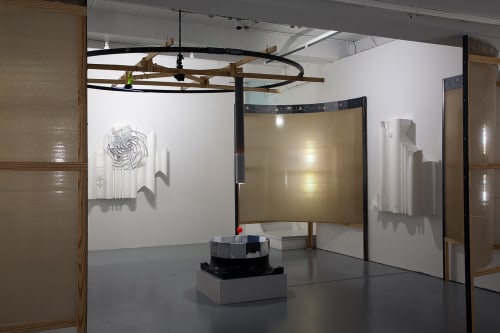Haseeb Ahmed's second solo exhibition at the gallery serves as an epilogue to his trilogy of Wind Egg Project exhibitions hosted by the Von Karman Institute for Fluid Dynamics, Harlan Levey Projects and the Museum of Contemporary Art in Antwerp (M HKA).
Haseeb Ahmed's transdisciplinary practice exists as clusters of experimental research that tangle us in science and myth. While drawing upon the hard sciences, the approach is not a scientistic one - that is, privileging the scientific method. Ahmed's use of contemporary technology and science emerge as a critique from within, directed at a society that imagines these fields to be their means of salvation, in the absence of other emancipatory political narratives. Yet, Ahmed neither seeks the messiah nor is he nostalgic for mythic thought. The artist is an omnivore. Propelled by a sense of ambivalence, he pushes data-by-accumulation to excess. If, in encountering his work, you get lost, you are on the right track.
In "The Meeting of Myth and Science," anthropologist Claude Levi-Strauss notes that, similar to mythology, science is the quest for "the invariant," meaning those aspects of our world and phenomenological experience that remain constant. This is sought to "find order in apparent disorder." Yet while mythology used narrative to organize the universe, it only gave the illusion of total understanding. Science, on the other hand, has demonstrated it can order nature. The schism between scientific and mythical thinking dates back to the seventeenth and eighteenth centuries, when scientists sought to prove their field was the hidden key to intellectual progress and discovery, a means of capturing (and subjugating) the world. Science's mastery of, and divorce from God-given nature was considered necessary at the advent of modernity, to give space for freedom of thought beyond ecclesiastic texts and interpretations. Yet in today's citation-driven, evidence-based world, the call to think freely appears banal. The scientific method builds theories from small proofs, operating on the probability of repetition and habitual knowledge. Yet science uses "a very limited amount of our mental power," in Levi-Strauss's view, sealing itself off from the plasticity of human understanding and absurd variability of human culture. Later on, in The Structure of Scientific Revolutions, Thomas Kuhn would write that paradigm shifts are needed to correct scientific thinking's blind spots. When anomalies and errors outnumber the evidence, new configurations of thought and a return to fundamental research is needed to embrace the unknown.
How might we outrun our current habits of thought? Ruach not Rauch - a space that unravels codes, exhausts the formal language of science and technology - reminds us that freedom remains at stake. Existing as an epilogue to ten years of Ahmed's research, the exhibition offers a series of cosmological rabbit holes to fall through, with propositions leading to more questions. Akin to chaos, the pause before the creation of the Universe, Ruach not Rauch exists in a threshold structure, like a wind tunnel, or a tower of silence. It lives between hypotheses and conclusions, prior to our over-considered, industrially produced world. It is an absurd place, confusing opposite and adjacent concepts. The title, a mix of Hebrew ('ruach,' i.e. the breath of God that created the world) and German ('rauch,' i.e. smoke arising from destruction) evokes the study of fluids, a recurring element in Ahmed's exploration.
At the very core of Ruach not Rauch is the vulture, both a symbol of death and species rumored since antiquity to be capable of immaculate conception.
An Exploded View
Ruach not Rauch is staged as an 'exploded view,' an architectural diagram implying the need to assemble component parts, which nest inside each other like a matryoshka doll. The layout presents as a small, controlled explosion of content about the wind, enacted in the architecture of a sacred, myth-bearing space, referencing the Parsi tower of silence, theories on the creation of the universe, and ornamentation from Ahmed's previous Wind Egg experiments. The industrially produced materials that appear throughout the exhibition - steel, fiberglass, aluminum, and EPS foam - are used for applied aerodynamics and fluids research, and in construction, to protect buildings from the force of the wind.
How might we outrun our current thinking? Ruach not Rauch– a space that unravels codes, exhausts the formal language of science and technology – reminds us that our freedom of thought remains at stake. Existing as an epilogue to ten years of Ahmed’s research, the exhibition offers a series of cosmological rabbit holes to fall through, with propositions only leading to more questions. Akin to chaos, the pause before the creation of the Universe, Ruach not Rauch exists in a threshold structure, like a wind tunnel or tower of silence. It lives between hypotheses and conclusions, prior to our over-considered, industrially produced world. It is a disorienting place, confusing opposite and adjacent concepts. The title, a mix of Hebrew (‘ruach,’ i.e. the breath of God that created the World) and German (‘rauch,’ i.e. smoke arising from destruction) evokes the study of fluids a recurring element in Ahmed’s exploration.
At the very core of Ruach not Rauch is the vulture, both a sign of death and a species rumored to have the capacity for immaculate conception.
Text by Meghana Karnik

